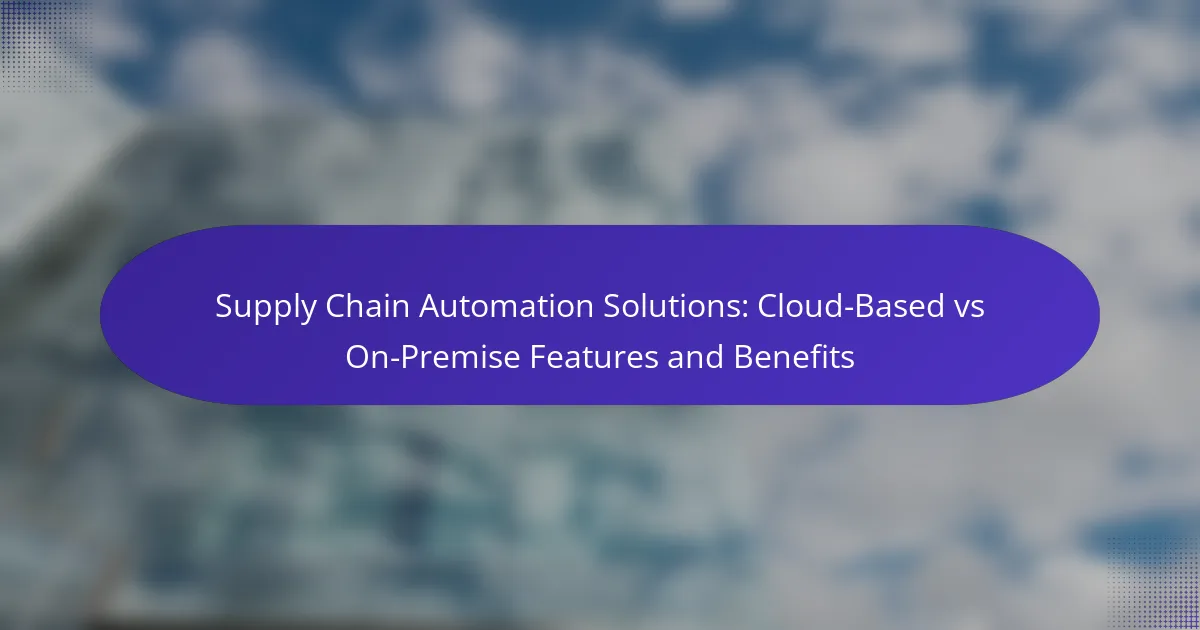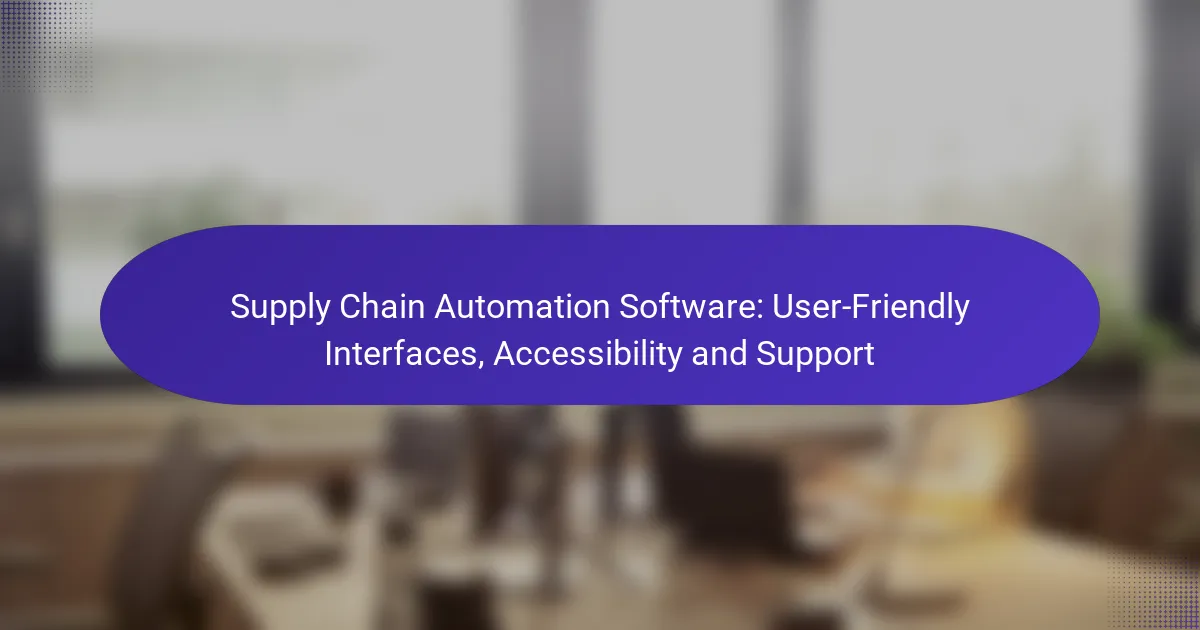In the evolving landscape of supply chain management, businesses face a critical decision between cloud-based and on-premise automation solutions. Cloud-based systems provide flexibility, scalability, and cost efficiency, enabling rapid adaptation to market dynamics. Conversely, on-premise solutions offer enhanced data security and customization, allowing for greater control over operations. Understanding the distinct features and benefits of each option is essential for organizations to align their supply chain strategies with their unique requirements.
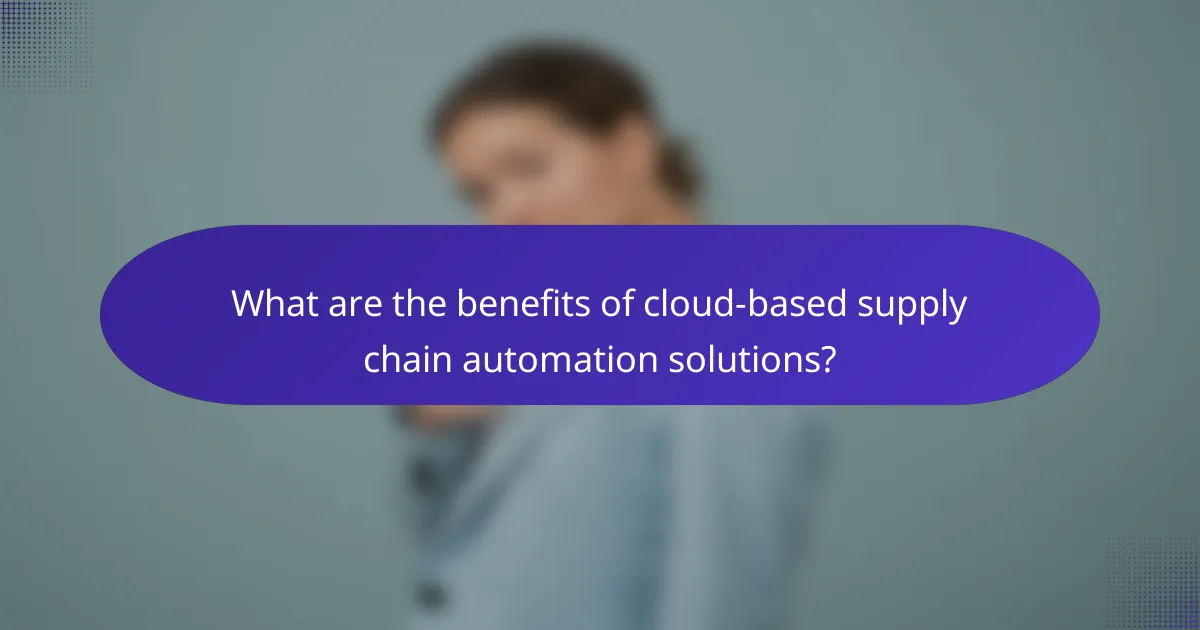
What are the benefits of cloud-based supply chain automation solutions?
Cloud-based supply chain automation solutions offer numerous advantages, including improved scalability, cost savings, and enhanced data accessibility. These systems allow businesses to streamline operations and respond quickly to market changes without the need for extensive on-premise infrastructure.
Scalability and flexibility
Cloud-based solutions provide significant scalability, enabling businesses to adjust their resources based on demand. This flexibility allows companies to easily scale up during peak seasons or downsize during slower periods without incurring heavy costs associated with physical hardware.
For example, a retailer can increase its cloud resources during the holiday shopping season and reduce them afterward, ensuring they only pay for what they use. This adaptability is crucial for businesses operating in dynamic markets.
Cost-effectiveness
Implementing cloud-based supply chain automation can lead to substantial cost savings compared to on-premise solutions. Businesses can avoid hefty upfront investments in hardware and software, opting instead for a subscription-based model that spreads costs over time.
Additionally, reduced maintenance and operational costs associated with cloud solutions can result in savings of up to 20-30% annually. This financial flexibility allows companies to allocate resources to other critical areas of their operations.
Real-time data access
Cloud-based systems facilitate real-time data access, allowing stakeholders to make informed decisions quickly. This immediate availability of information enhances visibility across the supply chain, enabling companies to respond to issues as they arise.
For instance, a manufacturer can monitor inventory levels in real-time, adjusting orders and production schedules to prevent stockouts or overstock situations. This proactive approach minimizes disruptions and optimizes efficiency.
Enhanced collaboration
Cloud solutions promote enhanced collaboration among supply chain partners by providing a centralized platform for communication and data sharing. This connectivity fosters better relationships and coordination between suppliers, manufacturers, and distributors.
With shared access to critical information, teams can work together more effectively, reducing delays and misunderstandings. For example, a logistics provider can instantly update shipping statuses, allowing all parties to stay informed and aligned.
Automatic updates and maintenance
One of the key benefits of cloud-based supply chain automation is automatic updates and maintenance. Providers regularly update their software to ensure users have access to the latest features and security enhancements without requiring manual intervention.
This reduces the burden on internal IT teams and ensures that businesses are always operating on the most current version of the software. As a result, companies can focus on their core operations rather than managing system upkeep.
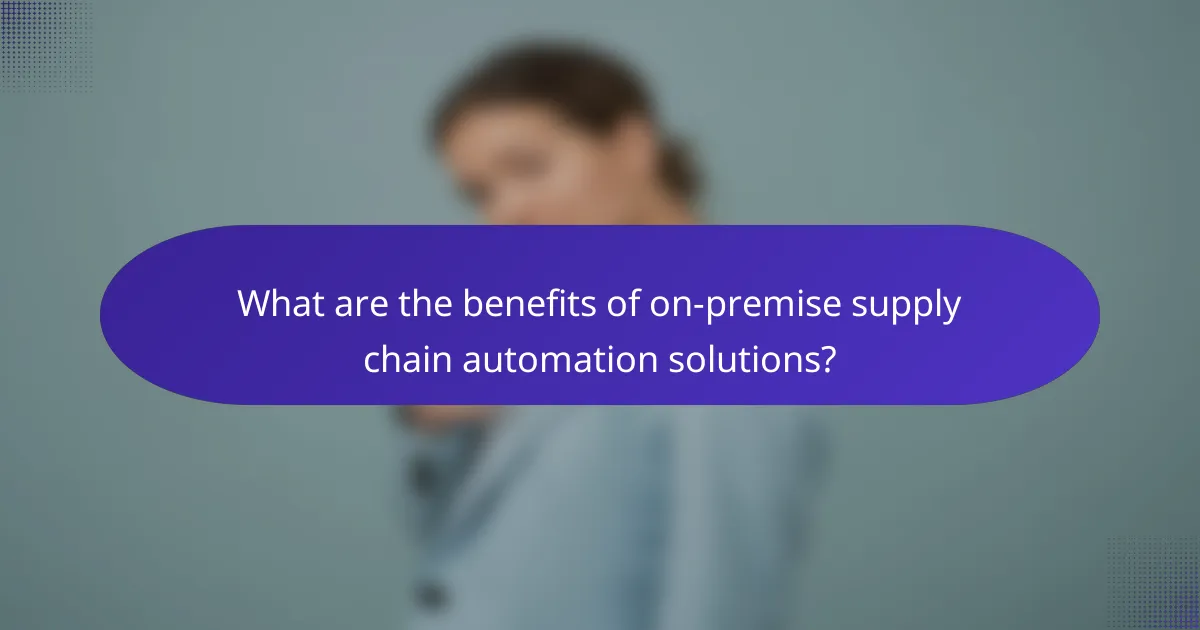
What are the benefits of on-premise supply chain automation solutions?
On-premise supply chain automation solutions offer several advantages, particularly in terms of data security, customization, and integration. These systems allow businesses to have greater control over their operations and data, which can lead to improved efficiency and compliance with industry regulations.
Data security and control
On-premise solutions provide enhanced data security as all sensitive information is stored locally, reducing the risk of external breaches. Companies can implement their own security protocols and access controls, ensuring that only authorized personnel can access critical data.
This level of control is especially important for industries that handle sensitive information, such as pharmaceuticals or financial services, where data privacy regulations are stringent. By maintaining data on-site, businesses can better manage compliance with these regulations.
Customization options
On-premise systems allow for extensive customization to meet specific business needs. Companies can tailor the software to fit their unique workflows, processes, and reporting requirements, which can lead to increased operational efficiency.
For example, a manufacturing firm might need specialized inventory management features that are not available in standard cloud solutions. With on-premise software, they can develop and integrate these features directly into their system.
Integration with existing systems
Integrating on-premise supply chain automation solutions with existing systems is often more straightforward than with cloud-based options. Businesses can connect their automation software directly to legacy systems without the complications of internet connectivity or third-party dependencies.
This direct integration can lead to smoother data flow across various departments, enhancing overall productivity. For instance, a company can link its on-premise automation solution with its ERP system to streamline order processing and inventory management.
Compliance with regulations
On-premise solutions can be designed to comply with specific industry regulations, which is crucial for sectors like healthcare and finance. Companies can ensure that their systems meet local and international standards by customizing features and processes according to regulatory requirements.
For example, a business in the European Union must comply with GDPR, and having an on-premise solution allows them to implement necessary data handling practices directly. This proactive approach can help avoid costly fines and enhance customer trust.
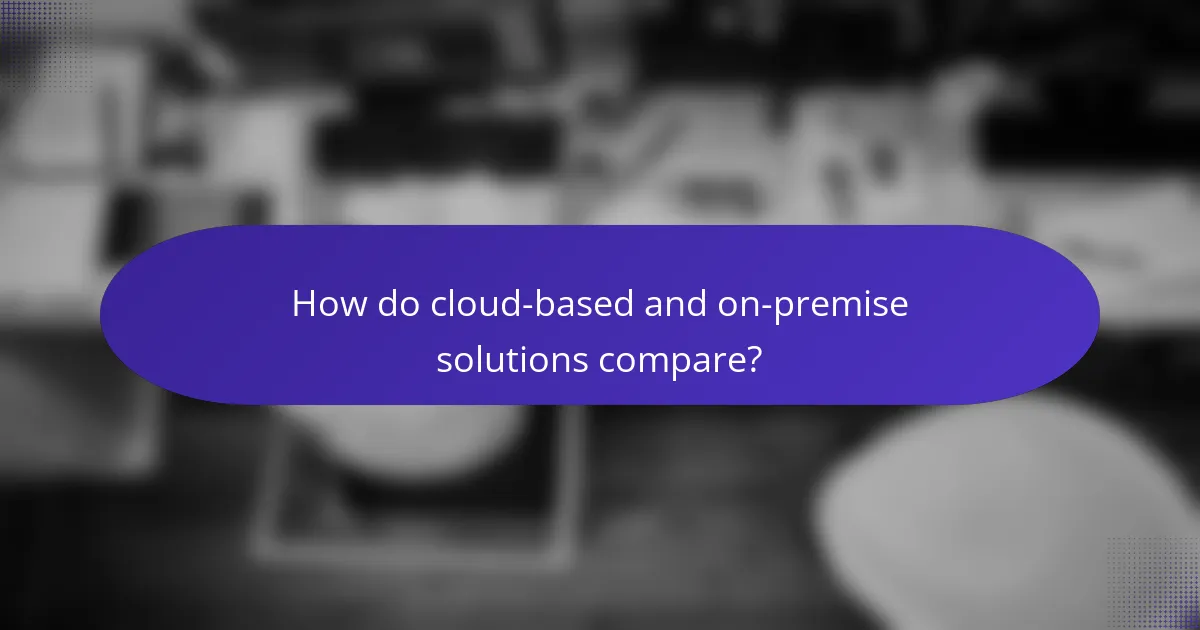
How do cloud-based and on-premise solutions compare?
Cloud-based and on-premise supply chain automation solutions differ significantly in terms of cost, implementation, maintenance, and performance. Choosing between them depends on your organization’s specific needs, budget, and infrastructure capabilities.
Cost comparison
Cloud-based solutions typically involve a subscription model, which can lead to lower upfront costs but may accumulate higher expenses over time. In contrast, on-premise systems require substantial initial investments in hardware and software, along with ongoing costs for updates and support.
For example, cloud solutions might range from hundreds to thousands of USD per month, depending on usage and features, while on-premise setups can start in the low tens of thousands of USD. Consider your long-term budget when evaluating these options.
Implementation timeframes
Cloud-based solutions often allow for quicker deployment, sometimes within days or weeks, as they do not require extensive hardware setup. On-premise implementations, however, can take several months due to the need for physical installations and custom configurations.
Organizations should assess their urgency for automation and choose accordingly. If immediate benefits are essential, cloud solutions are generally the better choice.
Maintenance responsibilities
With cloud-based systems, the service provider handles most maintenance tasks, including updates and security, freeing your team to focus on core operations. On-premise solutions place the burden of maintenance on your IT staff, requiring them to manage updates, troubleshoot issues, and ensure security compliance.
Consider your team’s capacity and expertise when deciding. If you lack a dedicated IT team, a cloud solution may be more manageable.
Performance metrics
Performance can vary significantly between cloud and on-premise solutions, with cloud systems often offering scalability and flexibility to adapt to changing demands. On-premise solutions may deliver consistent performance but can struggle with scalability without additional investments.
Evaluate your performance needs, such as processing speed and data handling capabilities. For businesses expecting rapid growth or fluctuating workloads, cloud solutions may provide the necessary agility.

What factors should businesses consider when choosing a solution?
Businesses should evaluate their specific needs, budget, existing IT infrastructure, and future growth plans when selecting a supply chain automation solution. Each of these factors plays a crucial role in determining whether a cloud-based or on-premise solution is more suitable.
Business size and needs
The size of a business significantly influences the choice between cloud-based and on-premise solutions. Smaller companies may benefit from cloud solutions due to lower upfront costs and scalability, while larger enterprises might require the customization and control that on-premise systems offer.
Additionally, the specific needs of the business, such as the complexity of supply chain operations and the volume of transactions, should guide the decision. For example, a company with a simple supply chain may find a cloud solution sufficient, while one with intricate logistics might need an on-premise setup for better integration with existing systems.
Budget constraints
Budget is a critical factor when choosing between cloud-based and on-premise solutions. Cloud solutions typically involve a subscription model, which can be more affordable for businesses with limited capital. On the other hand, on-premise solutions often require significant initial investment for hardware and software.
Businesses should consider not only the upfront costs but also ongoing expenses such as maintenance, updates, and support. A thorough cost-benefit analysis can help determine which option aligns better with financial resources and long-term goals.
IT infrastructure
The existing IT infrastructure of a business can dictate the feasibility of implementing either solution. Companies with robust IT departments and infrastructure may prefer on-premise solutions for greater control and customization. However, those lacking extensive IT resources might find cloud solutions more manageable and less resource-intensive.
It’s essential to assess the current technology stack and determine compatibility with potential automation solutions. Businesses should also consider the need for training and support for staff when transitioning to a new system.
Future growth plans
Future growth plans are vital when selecting a supply chain automation solution. Companies anticipating rapid expansion may favor cloud solutions due to their scalability and flexibility. Cloud systems can easily accommodate increased demand without significant additional investment.
Conversely, businesses with stable growth projections might opt for on-premise solutions, which can provide a sense of security and control over their data. Evaluating long-term business objectives will help ensure the chosen solution can adapt to changing needs and support growth effectively.
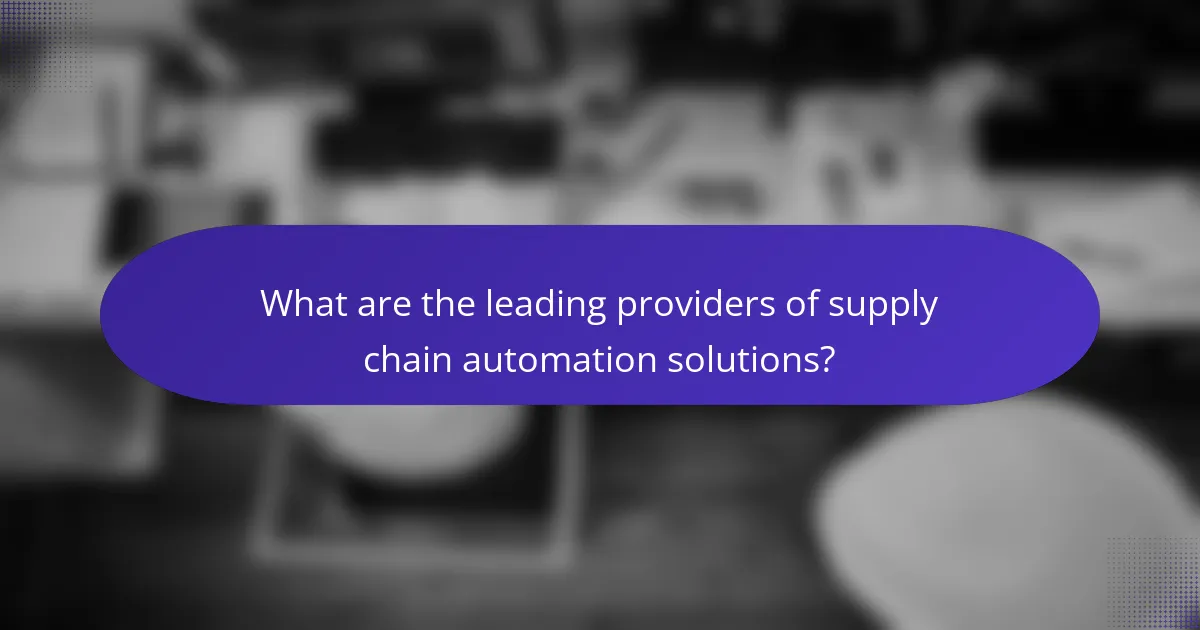
What are the leading providers of supply chain automation solutions?
The leading providers of supply chain automation solutions include companies like SAP, Oracle, and JDA Software. These providers offer a range of cloud-based and on-premise solutions designed to streamline logistics, inventory management, and overall supply chain efficiency.
Cloud-Based Solutions
Cloud-based supply chain automation solutions are hosted on the vendor’s servers and accessed via the internet. This model allows for easier scalability, as businesses can adjust their usage based on demand without significant upfront investment in hardware.
Providers like SAP and Oracle offer cloud solutions that typically include features such as real-time data analytics, automated reporting, and integration with other cloud services. These features can enhance collaboration across different departments and partners, improving overall supply chain visibility.
On-Premise Solutions
On-premise supply chain automation solutions are installed directly on a company’s servers and managed internally. This approach can provide greater control over data security and compliance, which is crucial for industries with strict regulatory requirements.
While on-premise solutions may require higher initial costs for hardware and software, they can be beneficial for companies with stable operations that prefer to maintain their infrastructure. However, updates and scalability can be more challenging compared to cloud-based options.
Comparative Benefits
When comparing cloud-based and on-premise solutions, consider factors such as cost, scalability, and control. Cloud solutions often have lower upfront costs and allow for rapid deployment, while on-premise solutions may offer better data security and customization.
For example, a mid-sized manufacturing company might benefit from a cloud-based solution for its flexibility and lower initial investment, while a large pharmaceutical company may prefer an on-premise solution to meet stringent regulatory standards.
